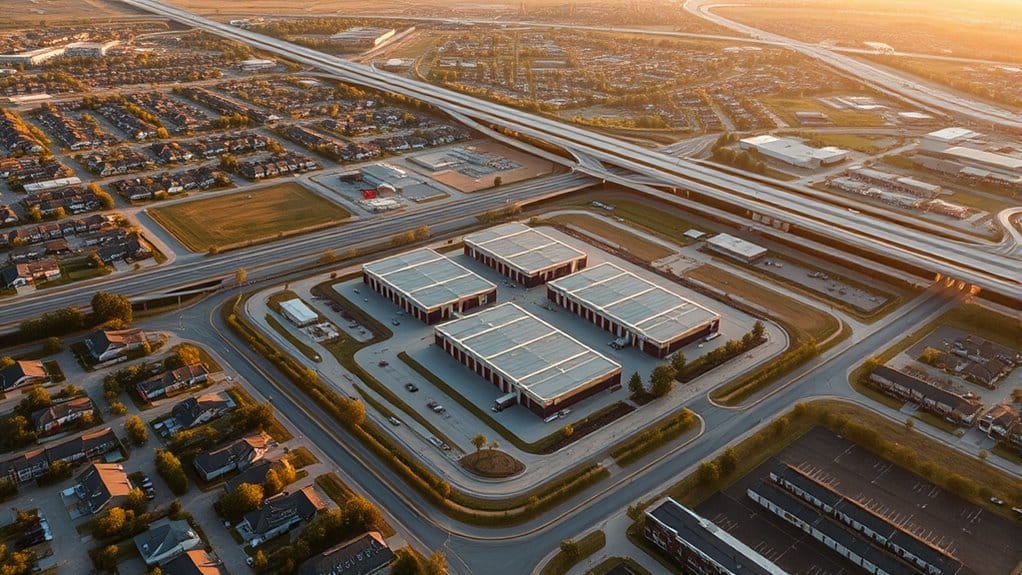When choosing a storage facility, location impacts both convenience and security of your belongings. You'll want a facility within 3-5 miles of your home or business for easy access, situated in a safe neighborhood with strong security measures. Consider local climate patterns, as some areas require climate-controlled units to protect against humidity or extreme temperatures. Market rates, population density, and traffic patterns also affect your storage experience. Exploring these location factors will help you make the best choice.
Proximity to Your Home or Business
When choosing a storage facility, proximity to your home or business should be a top priority, as it directly impacts your convenience and accessibility.
Studies show that facilities within a 3-5 mile radius of urban areas maintain over 90% occupancy rates, highlighting the strong preference for nearby storage solutions.
One of the key proximity benefits is the time you'll save accessing your belongings. Urban facilities average 546 units and often feature enhanced security and climate control, making them ideal for frequent visits.
These convenience factors become especially important if you're storing items you'll need to retrieve regularly. In high-density areas like Dallas and Houston, you'll find numerous facilities near residential and business zones, giving you options to balance accessibility with competitive pricing.
Consider facilities near retail hubs, as they typically offer better visibility and access.
Climate and Weather Considerations
When you're selecting a storage facility, you'll want to evaluate whether paying extra for climate control is worth the investment to protect your valuable items from temperature and humidity damage.
Your local weather patterns and seasonal changes will determine the level of climate protection you'll need, with coastal areas requiring more humidity control while desert regions need protection from extreme heat.
You'll find that climate-controlled units typically cost 20-30% more than standard units, but they're essential if you're storing electronics, wooden furniture, artwork, or other sensitive items that could warp, crack, or deteriorate in unstable conditions. Additionally, temperature stability is vital for preventing damage from extreme heat or cold.
Climate-Control Worth Extra Cost
Is the extra cost of climate-controlled storage really worth it? When you consider the climate benefits and potential savings from protecting your belongings, the $10 monthly premium often justifies itself.
Climate-controlled units maintain consistent temperatures and humidity levels year-round, preventing damage that could cost thousands to replace.
The cost justification becomes clearer when you're storing valuable or irreplaceable items. Your electronics, wooden furniture, and family heirlooms remain safe from extreme temperatures, whether it's scorching summers or freezing winters.
These units also protect against mold, mildew, and pests through enhanced insulation and regulated humidity levels of 30-50%. For long-term storage or items sensitive to environmental changes, you'll find that climate control isn't just a luxury—it's a smart investment in preserving your possessions.
Regional Weather Protection Needs
Different regions face unique storage challenges that'll affect your climate control needs. Coastal areas require robust storage solutions to combat high humidity and salt-air corrosion, while facilities in colder climates need protection against freezing temperatures.
You'll want to verify your chosen facility has appropriate weather resilience for your location. In areas with extreme temperature swings, look for facilities with advanced HVAC systems that can quickly adapt to changing conditions.
Desert regions need excellent cooling capabilities, while humid areas require effective dehumidification. Your facility should have high-quality insulation, proper sealing, and backup power systems to maintain consistent conditions during severe weather events.
Pay attention to whether the building materials and climate control systems match your area's specific challenges - this'll help protect your items year-round.
Neighborhood Safety and Security
Selecting a storage facility in a safe neighborhood plays an essential role in protecting your belongings from theft and vandalism.
You'll want to research neighborhood crime rates and evaluate the security measures in place at each facility you're considering. Look for high-resolution cameras, motion sensors, and electronic gate access systems that limit entry to authorized tenants only.
Choose facilities in well-lit areas near populated streets, as these locations typically experience fewer break-ins.
Pay attention to the surrounding properties - poorly maintained neighboring lots can increase security risks. You'll also benefit from facilities with 24/7 monitoring and on-site staff during business hours.
Don't forget to check police response times in the area, as slower emergency response zones require storage facilities with stronger security infrastructure.
Local Market Rates and Competition
Understanding local market rates can greatly influence your storage unit costs and value. When you're comparing facilities, it's crucial to conduct a competitive pricing analysis to guarantee you're getting the best deal.
Market rate fluctuations vary considerably by region, with some areas seeing dramatic increases while others experience sharp declines.
- Premium markets like Bellevue, WA ($190) and Dover, DE ($163) command higher rates due to strong demand.
- Texas markets show declining rates, with San Antonio (-26.8%) offering better deals for budget-conscious renters.
- Emerging markets like Columbia Falls, MT present opportunities with lower rates ($79) despite growing demand.
- Urban areas often face more competitive pricing due to facility saturation.
- Regional variations can create considerable price differences, so compare multiple locations within your search radius. Additionally, establishing a budget early can help you navigate cost considerations when selecting a storage facility.
Population Density and Development Plans

When you're evaluating potential storage facilities, consider how population density and urban growth in the area will affect future availability and pricing.
You'll want to check if the facility's location falls within planned development zones, as new construction projects can impact accessibility and property values.
Looking at population migration patterns in your target area can help you anticipate whether demand for storage units will increase or decrease, which directly affects your long-term storage options.
Urban Growth Drives Demand
The rapid growth of urban populations has dramatically shaped the self-storage industry's landscape, creating unprecedented opportunities for facility owners and investors.
With urbanization trends showing 82% of Americans living in urban areas and population density metrics indicating a need for 7-8 square feet of storage per capita, you'll find significant demand in developed city centers.
- Markets with less than 7 square feet per capita present strong expansion potential
- Urban renters, comprising 43.8 million households, drive storage adoption
- Life events and frequent relocations fuel consistent demand
- Population growth projections suggest 89% urbanization by 2050
- Minimum viable markets require 30,000 residents within 3-5 miles
You'll want to focus on undersupplied areas where existing facilities can't meet the growing needs of urban residents, particularly in regions experiencing high population growth and development.
Future Development Zone Impact
While urban population growth creates storage opportunities, successful facility development hinges on analyzing future development zones and their complex dynamics.
You'll want to pay attention to future zoning changes and storage trends, particularly in areas experiencing suburban-to-urban migration and mixed-use development.
As you evaluate potential storage locations, consider proximity to planned infrastructure improvements, such as highway expansions or transit routes. These developments can greatly impact accessibility and demand.
Additionally, you'll find that areas near housing complexes and retail hubs often show higher occupancy rates, averaging 96.5%.
Watch for emerging climate-related requirements, as they're reshaping facility designs and operating costs.
In high-density zones, where land availability is limited, competition for prime locations continues to intensify, making early identification of promising development areas vital. Furthermore, understanding extra services for long distance moves can enhance customer satisfaction and facility usage in these regions.
Population Migration Patterns
Understanding current population migration patterns proves essential for making informed storage facility decisions, as metro areas continue outpacing national growth trends.
Recent migration trends and urbanization effects have transformed metropolitan areas, with international immigration driving 94% of urban growth. When selecting a storage location, consider these key population shifts:
- Southern and Western states show the strongest population growth, suggesting increased storage demand
- Metro areas have gained 3.2 million residents, creating new market opportunities
- International migration has become the primary growth driver in urban centers
- Post-pandemic recovery has revitalized major cities like New York and Houston
- Urban labor markets are expanding due to workforce immigration
Additionally, the cultural diversity across East Coast states further influences local storage needs, as varying demographics may require different storage solutions.
You'll want to factor these demographic changes into your facility selection, as they directly impact storage needs and market potential in different areas.
Traffic Patterns and Accessibility
When selecting a storage facility location, traffic patterns and accessibility play essential roles in determining both operational success and customer satisfaction.
You'll want to evaluate the traffic flow around potential sites, ensuring there's enough visibility without overwhelming access points. While high-traffic areas boost marketability, storage facilities generate surprisingly low traffic - less than 7 car trips per 100 units daily.
Consider how easily you can enter and exit the facility during peak hours. The best locations offer dedicated turn lanes and efficient layouts that prevent queuing.
Look for facilities near major intersections or commercial hubs, but don't worry too much about congestion - even large storage facilities average less than 3 cars per hour.
Good accessibility means you won't waste time traversing complex routes or dealing with heavy traffic when visiting your unit.
Area Demographics and Storage Needs
The demographics of your target area directly shape the success of your storage facility business. Understanding demographic trends helps you tailor storage solutions to meet specific community needs.
Today's storage market reflects diverse demands, from downsizing Baby Boomers to mobile Millennials seeking flexible options.
- Multi-family housing residents often need extra space due to limited in-unit storage.
- Younger generations (Gen Z and Millennials) require temporary storage during frequent moves.
- Baby Boomers seek storage for heirlooms and transitional periods while downsizing.
- Price-sensitive renters in apartment-heavy areas prioritize affordable options.
- Multi-generational households drive demand for additional storage space.
Consider your area's unique mix of age groups, housing types, and income levels when planning your facility's unit sizes and pricing strategy.
This targeted approach guarantees you'll meet the specific storage needs of your local community.
Conclusion
When you're choosing a storage facility, location truly makes or breaks your experience. Consider Sarah, who chose a facility 30 minutes from her home to save $40 monthly - only to spend more on gas and waste countless hours in traffic. You'll want to weigh all location factors: accessibility, security, climate control, and market rates. Remember, the perfect storage spot balances convenience with cost while meeting your specific needs.



